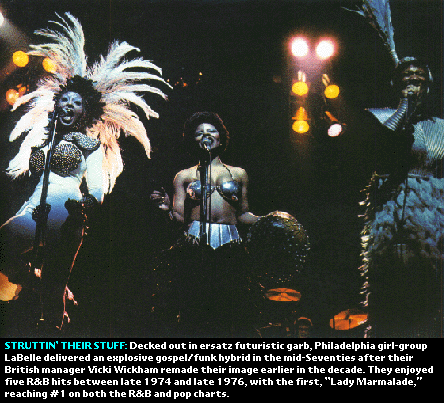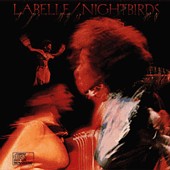|
LaBelle Epic 50048 Mar. 1975 Billboard: #1
Nolan and Crewe had written "Lady Marmalade" in 1974, and recorded it on an album by "The Eleventh Hour," a studio group fronted by Kenny's vocals. The song was written in pieces, Kenny explains. "I had one part of the song here and one part there, and it still needed something. Bob and I came up with the idea of 'Voulez-vous couchez avec moi ce soir.' It was like a puzzle that finally fit together." "Lady Marmalade" was from New Orleans, and so was producer Allen Toussaint, who heard the Eleventh Hour track and decided to record it on LaBelle. LaBelle wasn't a New Orleans group; Patti LaBelle, Nona Hendryx and Sara Dash were from Philadelphia, where they formed the group in 1962 with New Jersey native Cindy Birdsong, who left in 1967 to replace Florence Ballard in the Supremes. Patricia Holt and Cindy Birdsong were friends in high school. "We used to listen to records on the radio and think, hey, we could do that," Patti told Tony Cummings in The Sound of Philadelphia. "So we got together with this high school group called the Ordettes. We'd sing at parties, things like that. That was around '59 or so. The other girls in the Ordettes weren't serious about music... In about '60 this promoter called Bernard Montague took two girls from the Del Capris, another local group -- that was Sarah Dash and Nona Hendryx -- and we formed a new group. That's when we met Bobby Martin and became the Blue Belles." "We enjoyed recording with Bobby," Patti told Cummings. "He tried to show us how to get a professional attitude to our music, but we were just young kids. We did a pile of records for Newtown and we worked real hard trying to get another hit." In 1963, the group changed its name to Pattie LaBelle and the Blue Belles and made the Top 40 with an R&B ballad, "Down the Aisle." They recorded for Parkway and Atlantic, but during the latter half of the '60s they were best known as the group Cindy Birdsong left. Their fortunes changes in the '70s when they worked in England and met Vicki Wickham, who offered to manage them. After transforming their image and shortening the group name to a more contemporary LaBelle, they released an album on Warner Brothers in October, 1971, that met with great critical acclaim. There was more praise for the second album, Moonshadow, which featured six songs written by Hendryx. The rave reviews did not translate into hit records and they moved on to RCA. Their fusion of rock with R&B must have confounded radio station music directors, and their songs still failed to get airplay. They recorded an album with Laura Nyro, Gonna Take a Miracle, which included cover versions of Motown hits like "Jimmy Mack" and "You Really Got a Hold on Me." Then LaBelle signed with Epic Records in June, 1974. Their first project for the label was Nightbirds, an album recorded with producer Toussaint and his studio band, the Meters. Released as the first single from the album, "Lady Marmalade" broke in the discos and then spread to radio. It entered the Hot 100 on January 4, 1975, and went to number one 12 weeks later. LaBelle adapted a whole new space-age image but did not have another Top 40 hit. After one more album, Phoenix, the three members couldn't agree on a musical direction and split the group. Patti LaBelle and Nona Hendryx pursued solo careers, with Patti achieving massive solo success nearly a decade later with an eponymously-titled album of sassy funk and yearning ballads for Columbia. In 1982, she initiated an acting career, co-starring with Al Green in the Broadway revival of "Your Arm's Too Short to Box with God" and also appeared in the movie A Soldier's Story and on the television sitcoms A Different World and Out All Night. She won a Grammy in 1991 for Best R&B Female Vocal Performance for her album Burnin' and was honored with the Martin Luther King Lifetime Achievement Award, the Ebony Acheivement Award, and the NAACP Entertainer of the Year Award. Nona Hendryx, meanwhile, became prominent in New York's new-wave scene, singing backup on Talking Heads' Remain in Light and forming her own bands Zero Cool and Propaganda. She has recorded with and collaborated with such artists as Peter Gabriel, George Clinton, Mavis Staples, Prince and Yoko Ono, and her music was used in the films Perfect and Coming to America. In 2001, a remake of "Lady Marmalade" by Christina Aguilera, Pink, Lil' Kim, Missy Elliott and Mya reached the number one spot on the Billboard Hot 100 and was the #24 single on the magazine's year-end chart. It was also the world's best-selling single of 2001, moving 5.2 million copies internationally. At the 44th annual Grammy Awards in Los Angeles in February 2002, the five young singers were joined onstage by Lady Marmalade herself, Patti LaBelle, for a show-stopping rendition of the tune. - Fred Bronson, The Billboard Book of Number One Hits, Billboard, 1988.
No comments so far, be the first to comment. |


